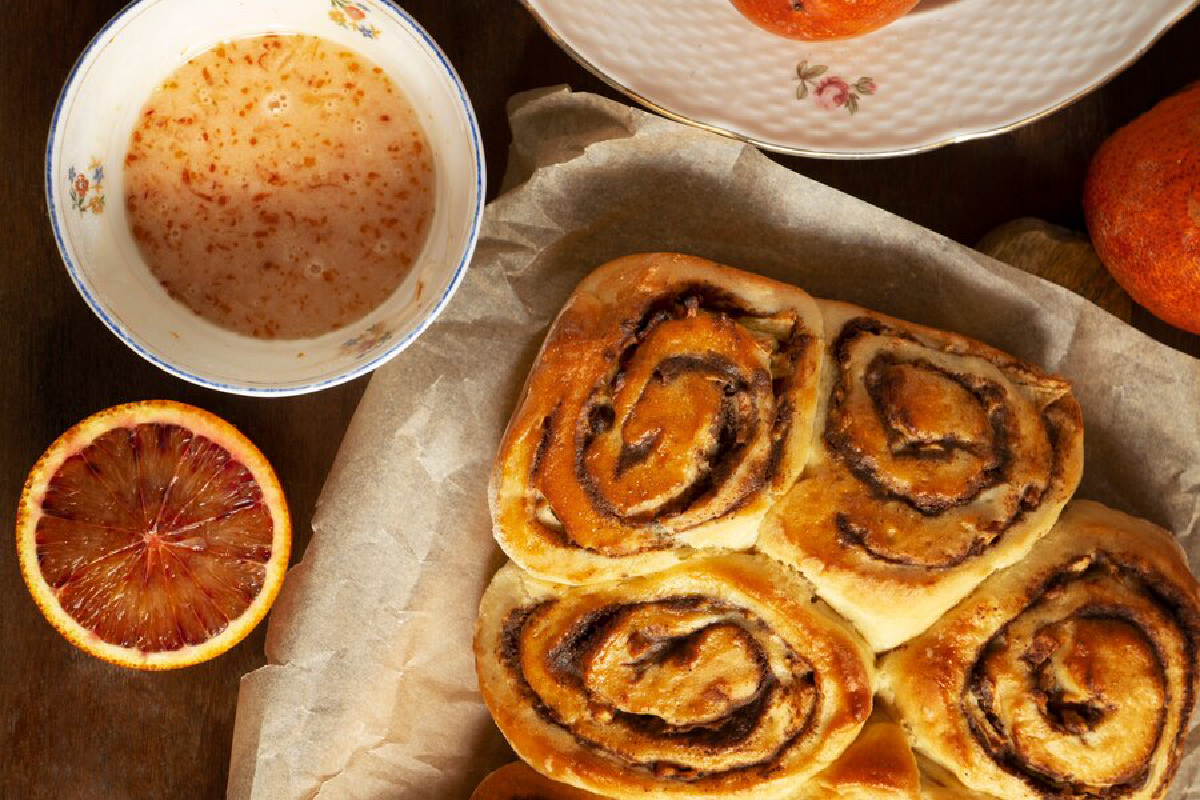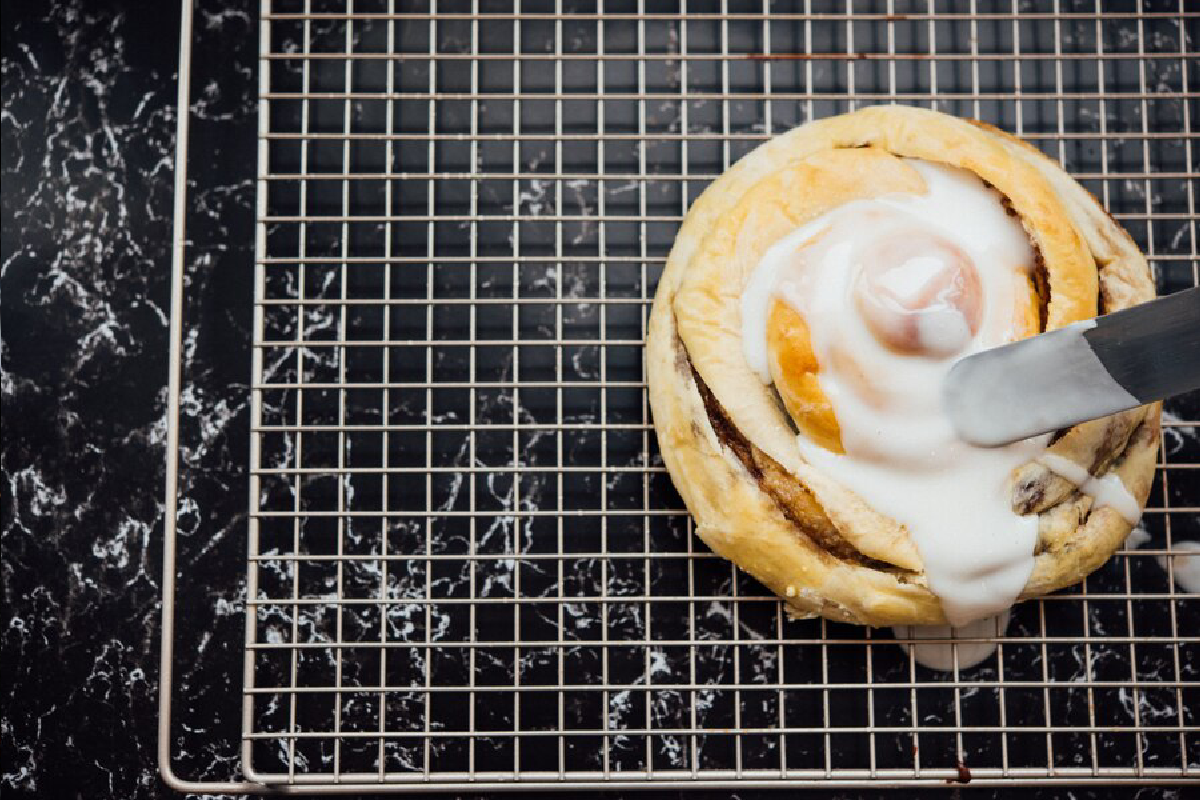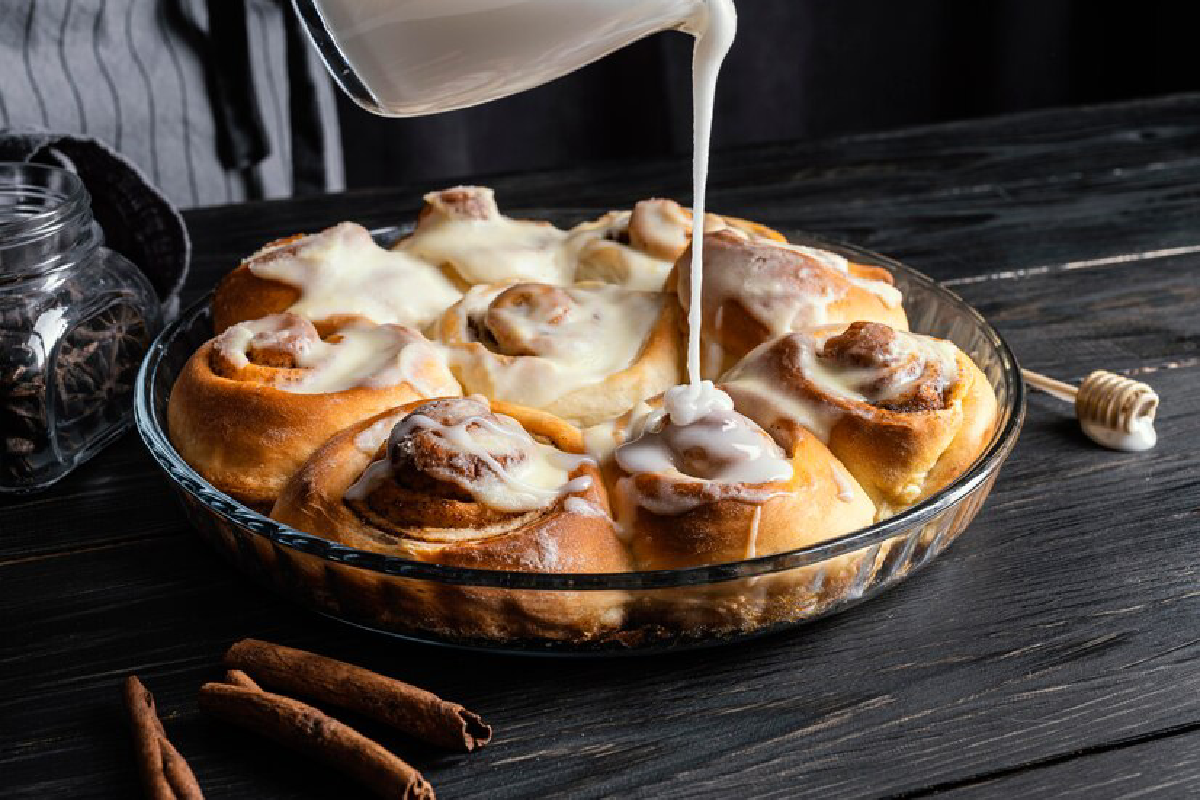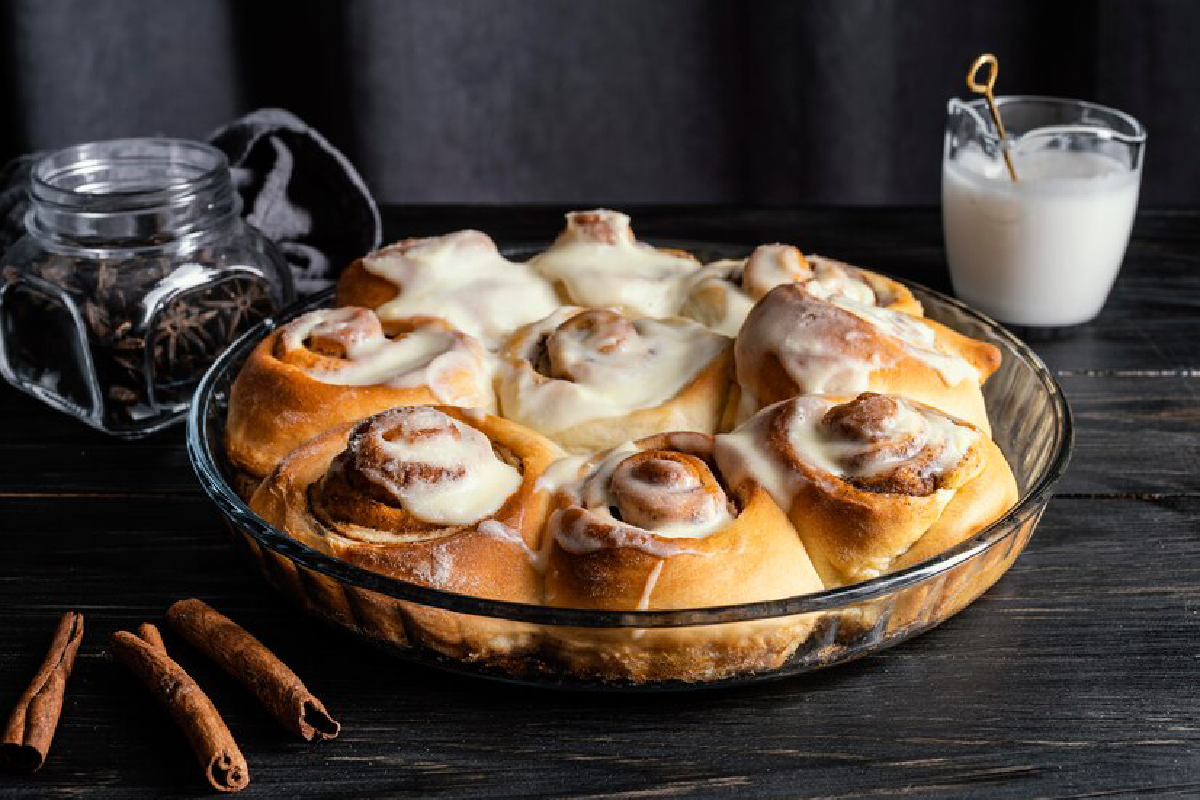Cinnamon rolls are a beloved breakfast pastry enjoyed by many, but have you ever wondered what makes up the delicious filling inside? The sweet, cinnamon-infused filling is what sets cinnamon rolls apart from other pastries, and knowing what it’s made of can help you appreciate this delicious treat even more.
The main ingredients in cinnamon roll filling are cinnamon, sugar, and butter. The cinnamon provides the signature flavor, while the sugar adds sweetness and the butter helps to bind everything together and create a smooth consistency. Some recipes may also include other spices, such as nutmeg or allspice, to add extra depth to the flavor.
The exact ratio of these ingredients can vary depending on the recipe, but most cinnamon roll fillings use a combination of about 1-2 tablespoons of cinnamon, 1/4-1/2 cup of sugar, and 1/4-1/2 cup of butter. Some recipes may also call for the addition of cream cheese or other ingredients to create a creamier filling. Regardless of the recipe, the end result is a delectable mixture that is sure to satisfy your sweet tooth.

Basic Ingredients
Cinnamon rolls are a delicious pastry treat that is loved by many people worldwide. The filling is the heart of the cinnamon roll, and it is what gives the pastry its distinct flavor. The basic ingredients of cinnamon roll filling are sugar, cinnamon, and butter.
Sugar
Sugar is a crucial ingredient in the cinnamon roll filling. It is what makes the filling sweet and gives it a caramelized texture. Brown sugar is commonly used in cinnamon roll filling as it has a higher molasses content than white sugar. This gives the filling a richer flavor and a darker color.
Cinnamon
Cinnamon is the spice that gives cinnamon rolls their distinct flavor. It is a warm and aromatic spice that is derived from the inner bark of the Cinnamomum tree. Ground cinnamon is commonly used in the filling, and it is what gives the filling its characteristic brown color.
Butter
Butter is the final ingredient in the cinnamon roll filling. It is what gives the filling its creamy texture and adds richness to the overall flavor. Unsalted butter is commonly used in the filling, and it is melted and mixed with the sugar and cinnamon to create a smooth and spreadable filling.
In conclusion, the basic ingredients of cinnamon roll filling are sugar, cinnamon, and butter. These ingredients, when combined, create a deliciously sweet and aromatic filling that is loved by many.
Dough Preparation
Yeast-Leavened Dough
To make cinnamon rolls, the dough is typically made using yeast-leavened dough. This type of dough requires active dry yeast, which is mixed with warm milk, sugar, and flour. The mixture is then left to sit for a few minutes to activate the yeast. Once the yeast is activated, the remaining ingredients, including flour, butter, and salt, are added to the mixture.
The dough is then kneaded until it becomes smooth and elastic. This process can take anywhere from 10 to 15 minutes. The dough is then left to rise in a warm, draft-free area for about an hour or until it has doubled in size.
Pastry Dough
Another option for making cinnamon rolls is to use pastry dough. This type of dough is made with flour, butter, and water. The ingredients are mixed together until they form a dough. The dough is then rolled out and folded several times to create layers.
To make cinnamon rolls using pastry dough, the dough is rolled out into a rectangle shape. The filling is then spread evenly over the dough, and the dough is rolled up tightly. The rolls are then cut into slices and baked until they are golden brown.
Regardless of which type of dough is used, the key to making delicious cinnamon rolls is to ensure that the dough is properly prepared and allowed to rise before baking.
Filling Variations
Cinnamon rolls are a classic pastry that can be enjoyed at any time of day. While the traditional cinnamon filling is delicious, there are many variations that can be used to add different flavors and textures. Here are a few popular filling variations:
Nuts and Spices
Adding nuts and spices to the filling can give the cinnamon roll a crunchy texture and a unique flavor. Chopped pecans, walnuts, or almonds can be mixed with the cinnamon and sugar to create a nutty filling. Spices like nutmeg, cardamom, or ginger can also be added to the mix to give the rolls a warm and spicy flavor.
Fruit Fillings
Fruit fillings can add a burst of freshness and sweetness to the cinnamon rolls. Common fruit fillings include apple, blueberry, and raspberry. To make a fruit filling, simply mix fresh or frozen fruit with sugar and cornstarch and spread it over the rolled-out dough before adding the cinnamon and sugar mixture.
Cream Cheese
Adding cream cheese to the filling can give the cinnamon rolls a tangy and creamy flavor. To make a cream cheese filling, mix softened cream cheese with sugar and vanilla extract and spread it over the rolled-out dough. Sprinkle the cinnamon and sugar mixture over the cream cheese and roll up the dough as usual.
Overall, there are many different variations of cinnamon roll filling that can be used to create a unique and delicious pastry. Experimenting with different flavors and textures can be a fun way to create a personalized cinnamon roll recipe.

Texture and Consistency
Spreadable Filling
Cinnamon roll filling is typically a spreadable mixture that is applied to the rolled-out dough before it is rolled up and sliced. The consistency of the filling is important as it needs to be thick enough to stay in place but also spreadable enough to cover the dough evenly. The filling is usually made with a combination of butter, sugar, and cinnamon, with some recipes adding other ingredients such as vanilla extract, nutmeg or cardamom.
To achieve the right texture, the butter should be softened but not melted, and the sugar should be granulated rather than powdered. This will help the filling to hold its shape and prevent it from melting or running out of the rolls during baking. Some recipes also suggest adding flour or cornstarch to the filling to thicken it up, but this can affect the taste and texture, so it’s best to use caution when doing so.
Layering Technique
Another important factor in the texture of cinnamon roll filling is the layering technique. To create the classic spiral shape, the dough is rolled out into a rectangle and then the filling is spread over the surface, leaving a small border around the edges. The dough is then rolled up tightly, starting from the long edge, and sliced into individual rolls.
The way the filling is layered can affect the texture and consistency of the finished rolls. If the filling is spread too thickly, it can overwhelm the dough and become too gooey or sticky. On the other hand, if the filling is too thin or unevenly distributed, the rolls may not have enough flavor or sweetness.
To achieve the perfect balance, it’s important to spread the filling evenly over the dough, leaving a small border around the edges to prevent it from leaking out. Some bakers also suggest using a pastry brush to spread the filling more evenly and avoid clumps or pockets of cinnamon and sugar.
Sweetness Levels
When it comes to cinnamon roll filling, sweetness is a crucial factor that can make or break the taste of the final product. Here are some considerations for adjusting sweetness levels in cinnamon roll filling:
Adjusting Sugar Content
Sugar is the primary sweetener used in cinnamon roll filling. However, the amount of sugar used can vary depending on personal preference. Some recipes call for a lot of sugar, while others use less.
If you prefer a less sweet cinnamon roll, you can reduce the amount of sugar in the filling. On the other hand, if you have a sweet tooth, you can increase the sugar content. Keep in mind that adjusting the sugar content can also affect the texture and consistency of the filling.
Alternative Sweeteners
If you want to reduce the amount of sugar in your cinnamon roll filling, there are alternative sweeteners you can use. These include honey, maple syrup, and agave nectar. These sweeteners can add a unique flavor to the filling and are often considered healthier alternatives to sugar.
However, it’s important to note that alternative sweeteners may affect the texture and consistency of the filling. Additionally, some alternative sweeteners may not be suitable for people with certain dietary restrictions or health conditions.
Overall, adjusting sweetness levels in cinnamon roll filling can be a matter of personal preference. By experimenting with different amounts of sugar and alternative sweeteners, you can find the perfect balance of sweetness for your taste buds.
Health Considerations
Low-Sugar Options
Cinnamon rolls are known for their sweet and indulgent flavor, but they can also be high in sugar. For those who are watching their sugar intake, there are some low-sugar options available. One option is to use a sugar substitute such as stevia or erythritol in the filling. These substitutes are low in calories and have a minimal impact on blood sugar levels.
Another option is to use a combination of cinnamon and other spices to add flavor without relying solely on sugar. For example, nutmeg, cardamom, and cloves can be used to create a warm and spicy filling. Additionally, using a whole-grain flour for the dough can add fiber and nutrients, which can help slow down the absorption of sugar.
Vegan Alternatives
For those who follow a vegan diet, traditional cinnamon roll fillings that contain butter and cream may not be an option. However, there are several alternatives that can be used instead. One option is to use a plant-based butter substitute such as coconut oil or vegan margarine. These options can provide a similar texture and flavor to traditional butter.
Another option is to use a non-dairy milk such as almond or soy milk instead of cream. These milks can be used to create a creamy filling without relying on animal products. Additionally, using a vegan-friendly sweetener such as maple syrup or agave nectar can provide a similar sweetness to traditional sugar.
Overall, there are several ways to modify cinnamon roll fillings to make them healthier or vegan-friendly. By using substitutes for sugar, butter, and cream, it is possible to create a delicious and satisfying treat that fits within a variety of dietary needs.
Cooking Methods
Baking Temperatures
When making cinnamon rolls, it is important to bake them at the correct temperature to ensure they are cooked through but not burnt. The ideal temperature for baking cinnamon rolls is between 350 and 375 degrees Fahrenheit. Baking at a lower temperature will result in undercooked rolls, while baking at a higher temperature may cause them to burn on the outside while remaining uncooked on the inside.
Moisture Control
Moisture control is also an important factor in baking cinnamon rolls. Too much moisture can result in soggy rolls, while too little moisture can cause them to become dry and hard. To ensure the perfect balance of moisture, it is recommended to brush the rolls with a mixture of melted butter and sugar before baking. This will help to keep the rolls moist and tender while also adding a touch of sweetness.
Another way to control moisture is to cover the rolls with aluminum foil during the baking process. This will help to trap in moisture and prevent the rolls from drying out. However, it is important to remove the foil during the last few minutes of baking to allow the rolls to brown and develop a crispy exterior.
By following these simple cooking methods, anyone can make delicious, perfectly cooked cinnamon rolls with a moist and tender texture.
Serving Suggestions
Glazes and Toppings
Cinnamon rolls are delicious on their own, but adding a glaze or toppings can take them to the next level. Here are some popular options:
- Cream cheese frosting: A classic topping for cinnamon rolls, cream cheese frosting is made with cream cheese, butter, powdered sugar, and vanilla extract. Its tangy sweetness pairs perfectly with the warm, spicy flavors of cinnamon rolls.
- Vanilla icing: A simple icing made with powdered sugar, milk, and vanilla extract, vanilla icing adds a sweet touch to cinnamon rolls without overpowering their flavor.
- Caramel sauce: For those who love a rich, buttery flavor, caramel sauce is a great option. Drizzle it over warm cinnamon rolls for a decadent treat.
- Chopped nuts: Adding chopped nuts like pecans or walnuts to the filling or sprinkling them on top of the glaze adds a satisfying crunch and nutty flavor to cinnamon rolls.
Pairing with Beverages
Cinnamon rolls are a perfect accompaniment to a hot cup of coffee or tea, but they can also be paired with other beverages for a satisfying breakfast or dessert. Here are some ideas:
- Hot chocolate: The rich, chocolaty flavor of hot chocolate is a perfect complement to the warm, spicy flavors of cinnamon rolls.
- Apple cider: For a fall-inspired treat, pair cinnamon rolls with a warm mug of apple cider. The sweet, tangy flavor of the cider pairs well with the cinnamon and sugar in the rolls.
- Milk: A classic pairing for any sweet treat, milk is a great option for those who want a simple beverage to enjoy with their cinnamon rolls.
- Iced coffee: For those who prefer a cold beverage, iced coffee is a refreshing choice. The creamy sweetness of the coffee pairs well with the warm, spicy flavors of the cinnamon rolls.
Frequently Asked Questions
How do you make cinnamon roll filling with brown sugar?
To make cinnamon roll filling with brown sugar, mix together brown sugar, cinnamon, and softened butter until it forms a smooth paste. Spread the mixture onto the rolled-out dough before rolling it up and slicing it into individual rolls.
What are the ingredients for a classic cinnamon filling recipe?
A classic cinnamon filling recipe typically includes brown sugar, cinnamon, and softened butter. Some recipes may also include a pinch of salt or vanilla extract for added flavor.
How can you create a gooey cinnamon roll filling?
To create a gooey cinnamon roll filling, add a layer of melted butter on top of the cinnamon sugar mixture before rolling up the dough. This will create a rich, buttery filling that will melt and caramelize as the rolls bake.
What alternatives can you use for cinnamon roll filling without brown sugar?
If you don’t have brown sugar on hand, you can use granulated sugar or a combination of granulated sugar and molasses to create a similar flavor and texture. You can also experiment with using honey, maple syrup, or other sweeteners to create a unique filling.
What is the secret to the flavor of Cinnabon’s cinnamon roll filling?
Cinnabon’s famous cinnamon roll filling is made with a blend of cinnamon, brown sugar, and margarine. The margarine gives the filling a rich, buttery flavor and helps it stay gooey and delicious.
What is the creamy topping typically found on cinnamon rolls?
The creamy topping found on cinnamon rolls is usually a simple mixture of powdered sugar, milk, and vanilla extract. Some recipes may also include cream cheese or butter for added richness and flavor.


